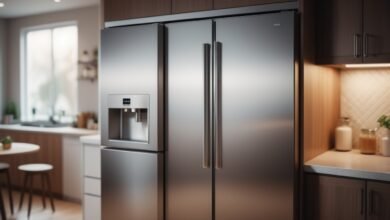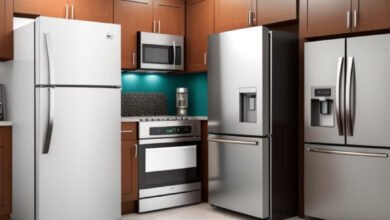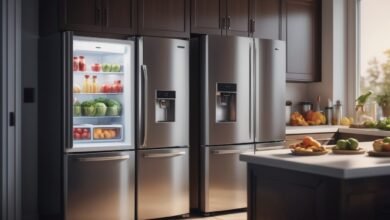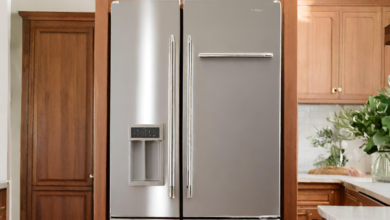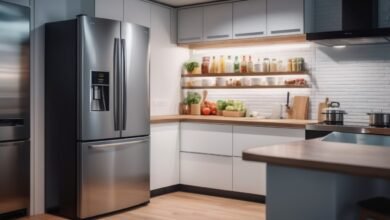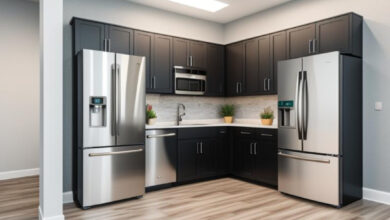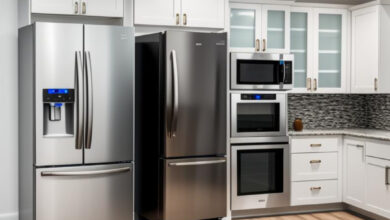Navigating Refrigerator Sizing: Factors to Consider for Your Space
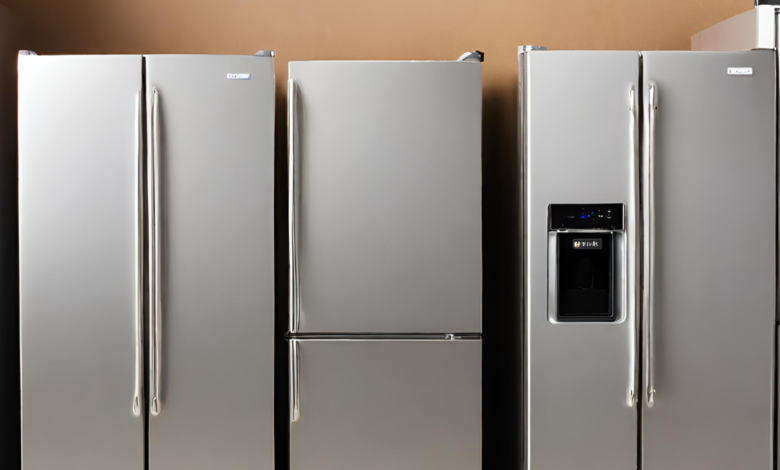
Choosing the right refrigerator size for your space is a crucial decision that impacts both the functionality and aesthetics of your kitchen. The market offers a variety of sizes and styles, making the selection process both exciting and challenging. In this comprehensive blog, we will explore the factors to consider when sizing a refrigerator for your space. From understanding your kitchen layout to assessing storage needs and energy efficiency, we’ll guide you through the intricate decision-making process to ensure your refrigerator seamlessly integrates into your culinary haven.
The Essence of Proper Sizing
A well-sized refrigerator is not only a practical necessity but also a design element that contributes to the overall harmony of your kitchen. By considering various factors and making informed choices, you can ensure that your refrigerator meets the specific needs of your household while enhancing the visual appeal of your living space.
Kitchen Layout Considerations
1. Measure the Available Space
Before delving into refrigerator options, measure the space where you intend to place the appliance. Measure the width, height, and depth of the designated area, considering any surrounding cabinets, countertops, or walls that may impact the size of the refrigerator that can comfortably fit.
2. Check Door Clearance
Consider the swing of the refrigerator doors. Ensure that there is enough space for the doors to open fully without hitting adjacent walls or cabinets. Some refrigerators come with reversible doors, allowing you to adjust the swing direction to suit your kitchen layout.
3. Evaluate Ventilation Space
Refrigerators require proper ventilation to operate efficiently. Leave clearance on the sides, back, and top of the refrigerator to ensure adequate airflow. This not only contributes to energy efficiency but also prevents the refrigerator from overheating.
4. Account for Levelling Adjustments
Check the levelness of the floor in the designated area. Some refrigerators come with adjustable legs or wheels to accommodate uneven floors. Ensuring a level base is crucial for the proper functioning of the refrigerator.
Types of Refrigerators and Their Sizes
5. Top-Freezer Refrigerators
Top-freezer refrigerators are a classic design with the freezer compartment located at the top. They typically have a width ranging from 28 to 33 inches, a height ranging from 61 to 69 inches, and a depth ranging from 28 to 32 inches. Consider this style if you prioritize freezer space and have height restrictions.
6. Bottom-Freezer Refrigerators
Bottom-freezer refrigerators have the freezer compartment at the bottom, usually as a pull-out drawer. They come in widths of 29 to 36 inches, heights ranging from 67 to 70 inches, and depths ranging from 30 to 34 inches. This style offers easy access to fresh foods at eye level.
7. Side-by-Side Refrigerators
Side-by-side refrigerators have vertical divisions between the fresh food and freezer sections. They are available in widths of 32 to 36 inches, heights ranging from 65 to 71 inches, and depths ranging from 28 to 34 inches. This style is suitable for kitchens with narrow spaces.
8. French Door Refrigerators
French door refrigerators combine a bottom freezer with side-by-side refrigerator doors on top. They come in widths of 30 to 36 inches, heights ranging from 67 to 70 inches, and depths ranging from 28 to 34 inches. This style is popular for its spacious and flexible interior.
9. Counter-Depth Refrigerators
Counter-depth refrigerators are designed to align with the depth of standard kitchen countertops. They typically have a depth ranging from 23 to 27 inches, making them suitable for kitchens with limited space. Widths and heights vary similar to standard-depth models.
10. Built-In Refrigerators
Built-in refrigerators are custom-designed to seamlessly blend with kitchen cabinetry. They come in various widths, typically ranging from 30 to 48 inches, with heights and depths similar to other refrigerator styles. Built-in models often have a standard or counter-depth design.
Assessing Storage Needs
11. Determine Household Size
Consider the number of people in your household when determining storage needs. A larger family may require a refrigerator with more storage space to accommodate groceries for multiple meals.
12. Evaluate Cooking Frequency
Assess how often you cook at home. If you prepare meals regularly, you’ll likely need a refrigerator with ample space for fresh ingredients, leftovers, and meal prep items. Those who cook less frequently may require a smaller unit.
13. Consider Freezer Requirements
Evaluate your freezer requirements. If you frequently buy frozen foods or batch-cook and freeze meals, a refrigerator with a larger freezer capacity is essential. Some models offer additional freezer drawers or compartments for better organization.
14. Assess the Type of Storage
Consider the types of items you need to store in your refrigerator. If you frequently purchase large items or bulk groceries, you may need adjustable shelves and bins to accommodate varying sizes. Evaluate the design and flexibility of the interior storage.
Energy Efficiency and Environmental Impact
15. Look for Energy Star Certification
Energy Star-certified refrigerators meet strict energy efficiency guidelines set by environmental protection agencies. Choosing an Energy Star-rated refrigerator not only reduces your utility bills but also minimizes environmental impact.
16. Consider Inverter Technology
Refrigerators with inverter technology are more energy-efficient. This technology adjusts the compressor speed based on cooling needs, resulting in less energy consumption and quieter operation.
17. Evaluate LED Lighting
LED lighting is not just about aesthetics; it also contributes to energy efficiency. Refrigerators with LED lighting consume less energy than traditional incandescent bulbs and provide bright, uniform illumination.
Budget Considerations
18. Set a Realistic Budget
Determine your budget for a new refrigerator. While larger and feature-rich models may be enticing, it’s essential to align your budget with your actual needs. Consider long-term savings in energy costs when investing in an energy-efficient model.
19. Explore Financing Options
Some retailers offer financing options for appliances. If a refrigerator with all the features you desire is slightly above your budget, explore financing plans that allow you to make manageable monthly payments.
20. Compare Long-Term Costs
Consider the long-term costs of owning a refrigerator. Energy-efficient models may have a higher upfront cost but can result in significant savings on energy bills over the lifespan of the appliance.
Additional Features and Convenience
21. Ice and Water Dispensers
Refrigerators with built-in ice and water dispensers add convenience but may impact the overall size and cost. Consider whether these features align with your preferences and daily routine.
22. Smart Refrigerator Features
Explore smart refrigerator features, such as touchscreen displays, Wi-Fi connectivity, and app integration. While these features may enhance convenience, it’s essential to weigh their importance against the potential increase in cost.
23. Door-in-Door Design
Some refrigerators come with a door-in-door design that allows you to access frequently used items without fully opening the door. While convenient, this feature may impact the overall storage capacity.
Practical Considerations
24. Check for Door Clearance
Ensure that the refrigerator can be brought into your kitchen without any issues. Measure doorways, hallways, and
stairwells to guarantee that the refrigerator can be delivered and installed without complications.
25. Evaluate Door Swing
Consider the swing of the refrigerator doors in relation to adjacent walls or cabinets. Reversible doors provide flexibility in adjusting the swing direction to suit your kitchen layout.
26. Opt for Adjustable Shelves and Bins
Flexible interior storage is essential for accommodating items of varying sizes. Opt for refrigerators with adjustable shelves and bins that can be customized to suit your storage needs.
Future-Proofing Your Investment
27. Anticipate Future Changes
Consider any upcoming changes in your household, such as the addition of family members or changes in lifestyle. Opting for a slightly larger refrigerator than your current needs may account for future growth.
28. Evaluate Resale Value
If you anticipate moving or upgrading your appliances in the future, consider the resale value of the refrigerator. Popular brands and models with desirable features may retain their value better over time.
29. Flexible Storage Solutions
Choose a refrigerator with flexible storage options that can adapt to changing needs. Features like adjustable shelves, removable bins, and convertible compartments provide versatility for varying storage requirements.
Conclusion
Sizing a refrigerator for your space is a nuanced process that involves careful consideration of your kitchen layout, storage needs, energy efficiency, budget, and additional features. By understanding these factors and making informed choices, you can ensure that your refrigerator not only meets your practical requirements but also enhances the overall aesthetic of your kitchen. Take the time to measure accurately, explore various styles, and envision how the refrigerator will seamlessly integrate into your daily life. With the right-sized refrigerator, you’ll create a kitchen space that is both functional and visually appealing. Happy refrigerating!
